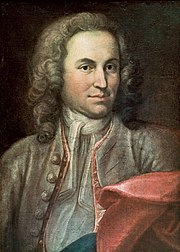Mein Herze schwimmt im Blut, BWV 199

Mein Herze schwimmt im Blut (My Heart Swims in Blood) is a cantata by Johann Sebastian Bach. In Wolfgang Schmieder's catalogue of Bach's works, it is BWV 199. The bulk of the text, which concerns a sinner finding redemption through God, is taken from Georg Christian Lehms Gottgefälliges Kirchen-Opffer (a little earlier, he had drawn on the same source for Widerstehe doch der Sünde, BWV 54). The piece was composed in Weimar in 1714 for performance on the eleventh Sunday after Trinity. It is written for solo soprano accompanied by oboe, two violins , viola, and basso continuo. Bach made major and minor revisions to the cantata for later performances, and the Neue Bach-Ausgabe recognizes two distinct versions: one (the first Weimar version) beginning in C minor with a viola obbligata in the sixth movement and a second (the Leipzig version) a tone higher, with the obbligata viola part given to a violoncello piccolo.
The cantata is in eight parts:
- "Mein Herze schwimmt im Blut" - a recitative for soprano accompanied by the strings.
- "Stumme Seufzer, stille Klagen" - a slow da capo aria for the soprano, oboe and continuo. There is a brief secco recitative before the da capo.
- "Doch Gott muss mir genädig sein" - a recitative with strings accompaniment.
- "Tief gebückt und voller Reue" - a da capo aria marked Andante (at a walking pace), in 3/4 time and accompanied by the strings. There is an adagio (slow) passage just before the da capo.
- "Auf diese Schmerzensreu" - a short recitative accompanied by the continuo.
- "Ich, dein betrübtes Kind" - Verse three of the chorale "Wo soll ich fliehen hin" with an obbligato viola or cello part (depending on the version).
- "Ich lege mich in diese Wunden" - a recitative accompanied by the strings.
- "Wie freudig ist mein Herz" - a cheerful gigue-like da capo aria accompanied by all the instruments in 12/8 time.
Recordings
- J.S. Bach: Complete Cantatas Vol. 2, Ton Koopman, Amsterdam Baroque Orchestra & Choir, Barbara Schlick, Antoine Marchand
- Angel's Hide Their Faces: Dawn Upshaw Sings Bach and Purcell, Arthur Haas, harpsichord & organ, Myron Lutzke, cello, Released March, 2001, Nonesuch: CD 79605-2
